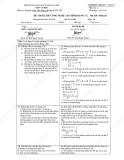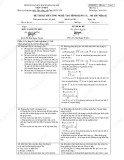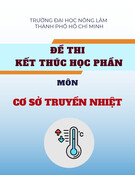
REGULAR ARTICLE
Evaluating nuclear data and their uncertainties
Patrick Talou
*
Nuclear Physics Group, Theoretical Division, Los Alamos National Laboratory, LosAlamos, USA
Received: 8 December 2017 / Received in final form: 21 February 2018 / Accepted: 17 May 2018
Abstract. In the last decade or so, estimating uncertainties associated with nuclear data has become an almost
mandatory step in any new nuclear data evaluation. The mathematics needed to infer such estimates look
deceptively simple, masking the hidden complexities due to imprecise and contradictory experimental data and
natural limitations of simplified physics models. Through examples of evaluated covariance matrices for the
soon-to-be-released U.S. ENDF/B-VIII.0 library, e.g., cross sections, spectrum, multiplicity, this paper
discusses some uncertainty quantification methodologies in use today, their strengths, their pitfalls, and
alternative approaches that have proved to be highly successful in other fields. The important issue of how to
interpret and use the covariance matrices coming out of the evaluated nuclear data libraries is discussed.
1 The current paradigm
The last two decades have seen a significant rise in efforts to
quantify uncertainties associated with evaluated nuclear
data. Most general purpose libraries now contain a
relatively large number of covariance matrices associated
with various nuclear data types: reaction cross sections,
neutron and gmultiplicities, neutron and gspectra,
angular distributions of secondary particles. The evalua-
tion process often follows a common procedure:
–collect and analyze experimental differential data on
specific reaction channels;
–perform model calculations to represent those data;
–apply a Bayesian or other statistical approach to tune the
model input parameters to fit the experimental differen-
tial data;
–use the newly evaluated data in transport simulations of
integral benchmarks;
–cycle back to original evaluation to improve performance
of the library on those benchmarks;
–continue cycle until “satisfied”.
Differential data correspond to those that pertain to
specific physical quantities associated with a single reaction
channel, e.g., (n,2n) cross sections (see Fig. 1). Oftentimes,
cross sections are not measured directly but instead only
their ratio to another cross section such as a “standard”are
reported. Such data also fall in the “differential data”
category.
On the other hand, integral data represent those that
can only be obtained by a more or less complex
combination of differential quantities. Perhaps the most
emblematic integral data in our field is the neutron
multiplication factor k
eff
of the Jezebel Pu fast critical
assembly (see Fig. 2). This factor does not represent a
quantity intrinsic to the isotope (
239
Pu) or to a particular
reaction channel, as opposed to differential data. Its
modeling requires a careful representation of the geometry
of the experimental setup and the use of more than one
nuclear data set: average prompt fission neutron multiplic-
ity v, average prompt fission neutron spectrum (PFNS),
neutron-induced fission cross section s
f
of
239
Pu are the
most important data for accurately simulating Jezebel k
eff
.
Such integral data are incredibly useful to complement
sparse differential data, limited physics models, and are
broadly used to validate nuclear data libraries.
Figure 3 shows several C/Ecalculated-over-experi-
ment ratios of basic benchmarks used to validate the latest
U.S. ENDF/B-VIII.0 library [3]. Most points cluster
around C/E= 1.0, demonstrating that the simulations
reproduce the experimental values extremely well. The
high performance of the library to reproduce this
particular suite of benchmarks is no accident, but instead
the result of various little tweaks that have been applied to
the underlying evaluated nuclear data to reproduced those
benchmarks accurately. This fine-tuning of the library is a
very contentious point, which is discussed in this
contribution.
If the uncertainties are based solely on differential data,
the uncertainties associated with the evaluated nuclear
data and propagated through the transport simulations
produce very large uncertainties on the final simulated
integral numbers. For instance, propagating the very small
(less than 1% at the time of the referenced work) evaluated
uncertainties in the
239
Pu fission cross sections to the
*e-mail: talou@lanl.gov
EPJ Nuclear Sci. Technol. 4, 29 (2018)
©P. Talou, published by EDP Sciences, 2018
https://doi.org/10.1051/epjn/2018032
Nuclear
Sciences
& Technologies
Available online at:
https://www.epj-n.org
This is an Open Access article distributed under the terms of the Creative Commons Attribution License (http://creativecommons.org/licenses/by/4.0),
which permits unrestricted use, distribution, and reproduction in any medium, provided the original work is properly cited.

prediction of Jezebel k
eff
still led to a spread in the
distribution of calculated k
eff
of 0.8% [4]. This is to be
compared with a reported experimental uncertainty of
about 0.2% for this quantity. This is reasonable since our
knowledge of the integral benchmarks has not been folded
in the evaluation process. However, the expected distribu-
tion of C/Evalues across many benchmarks should reflect
these relatively large errors. It is not the case, as shown in
Figure 3, for the reason that the library was slightly tuned
to reproduce this limited set of benchmarks.
If, on the other hand, the uncertainties are based solely
on model calculations, the standard deviations tend to get
rather small with large correlated terms, i.e., strong off-
diagonal elements of the covariance matrix.
Another point of contention has been the lack of
cross-correlation between the low-energy, resolved and
unresolved resonance range, and the higher fast energy
range evaluations, as seen for instance in Figure 4 for the
239
Pu(n,g) correlation matrix in ENDF/B-VIII.0. This is
not a mistake but simply the reflection that two
evaluation procedures were used to produce this combined
picture of the uncertainties. Since the two energy ranges of
the evaluation were done independently, using distinct
experimental information and model calculations, it is not
unreasonable to obtain null correlation terms between the
two blocks. However, better approaches being developed
[5] would create more realistic correlations between those
energy ranges.
2 An ideal evaluation
The promise of an evaluated nuclear data library is to
report values of nuclear physical quantities as accurately as
possible, given the state of our knowledge at the time the
library is produced. With this in mind, all pertinent
information and data related to the quantity of interest
should be used to infer its most accurate value and
uncertainty. So not only differential data, model calcu-
lations, but any other relevant data, including integral data
should naturally enter into the evaluation process. The
current paradigm is a bit murkier, blending the line
between differential and integral data, and “calibrating”
evaluated data in order for the library to perform well when
used in benchmark calculations. Although the mean values
of the evaluated data are readjusted slightly to improve the
performance of the library against critical benchmark
validations, this readjustment is typically not included in
the derivation of the associated covariance matrices,
leading to an inconsistency in the evaluation process. A
more rigorous approach would definitely have to include
this step explicitly.
In the following, I describe what could be considered an
“ideal”evaluation, including a realistic quantification of
experimental uncertainties and correlations, the inclusion
of all available information, the use of comprehensive
physics models, the respect of basic physics constraints,
and finally an estimation of unknown systematic biases.
2.1 Realistic experimental uncertainties and
correlations
Most often, experimental differential data are conveniently
retrieved from the EXFOR database [6]. This is a powerful
tool for the evaluator who is trying to mine data related to
specific isotopes and reactions, often spanning a wide range
of years when the experiments were performed. Its
potential use is however limited. Besides being incomplete,
sometimes difficult to navigate because of the possibility to
store the same data in different categories, or simply not
flexible enough to accommodate complicated data sets
Fig. 1. The ENDF/B-VIII.0 evaluated
239
Pu(n,2n) cross section
and one-sigma uncertainty band are shown in comparison with
several experimental data sets.
Fig. 2. The Jezebel
239
Pu critical assembly shown above is widely
used by nuclear data evaluators to constrain their evaluations of
neutron-induced reactions on
239
Pu, creating hidden correlations
between different quantities such as v, PFNS and s
f
, as discussed
by Bauge and Rochman [1] and Rochman et al. [2].
2 P. Talou: EPJ Nuclear Sci. Technol. 4, 29 (2018)

(e.g., multi-dimensional data sets), it also lacks an
important feature for use with modern data mining
algorithms: meta-data. Although the information is often
present in the original reports and published journal
articles, it is often missing in the terse summary provided in
EXFOR, or if present, can be buried in text that would be
difficult to interpret using simple algorithms.
Such information is crucial in trying to estimate cross-
experiment correlations. As an example, Figure 5 shows the
correlation matrix obtained by Neudecker et al. [7] for the
235
U thermal PFNS, covering four distinct but correlated
experimental data sets. Missing such type of correlations
can lead to much smaller final estimated uncertainties
when using any least-square or minimization technique. A
recent example is the uncertainty associated with the
standard
252
Cf (sf) vpreviously estimated at 0.13% [8] and
now revised to 0.4% [9] simply based on the inclusion of
cross-experiment correlations.
In the case of integral data, DICE [10], Database for the
International Criticality Safety Benchmark Evaluation
Project Handbook [11] is a relational database that goes a
long way toward this goal of organizing complex and multi-
dimensional information. A rather extensive set of queries
can be performed, e.g., experimental facility, isotope, fuel-
pin cell composition, and can be used efficiently to
investigate the importance of specific nuclear data for
particular applications. A similar approach should be
undertaken for storing and mining a database of experi-
mental differential data.
2.2 Use of all information
A controversial question surrounding the current paradigm
is the somewhat arbitrary separation in the use of
differential versus integral data in the nuclear data
Fig. 3. Basic benchmarks used in the validation of the ENDF/B-VIII.0 library [3]. Overall the ENDF/B-VIII.0 library (in red)
performs even better than the ENDF/B-VII.1 (in green) for this particular suite of integral benchmarks.
Fig. 4. The correlation matrix evaluated for
239
Pu (n,g)in
ENDF/B-VII.1 shows two uncorrelated blocks for two energy
regions, meeting at 2.5 keV, the upper limit of the unresolved
resonance range.
P. Talou: EPJ Nuclear Sci. Technol. 4, 29 (2018) 3

evaluation process. By siding on the side of caution and not
including (properly) integral data into this process, the
evaluation of uncertainties becomes inconsistent and
somewhat difficult to defend and interpret. It is important
to understand that the current evaluated covariances do
not reflect our complete knowledge on the underlying data.
For instance, the experimental uncertainty on the k
eff
of
Jezebel estimated to be about 0.2%. When uncertainties
stemming from nuclear data (neutron-induced cross
sections, PFNS, v, angular distributions of secondary
particles) are propagated in the transport simulation of
Jezebel, the calculated uncertainty [3]onk
eff
is greater than
1%. Although the mean value of Jezebel is used as a
“calibration”point for the library, this information is not
reflected or used in the evaluation of the data covariance
matrices. When looking more broadly at a suite of
benchmarks, the C/Evalues cluster around 1.0 with a
distribution much narrower than would be obtained if the
nuclear data covariance matrices were sampled (see Fig. 3
for instance).
“Good”reasons abound for why this separation of
integral vs. differential data exist in the first place, and why
we face this somewhat inconsistent situation. One of those
reasons is that integral data cannot provide a unique set of
nuclear data that represent the measured data. To again
consider the example of Jezebel, many combinations of
PFNS, vand s
f
of
239
Pu would be consistent with the
measured data, leading to correlations [2] not taken into
account in current evaluations. Smaller effects, such as
impurities of
240
Pu, would also impact the result. Besides
nuclear data, uncertainties in the geometry, mass,
impurities could be underestimated leading to a misstated
overall uncertainty on k
eff
. Also, and most importantly, the
creation of an adjusted library would tend to tune nuclear
data in the wrong place, away from what differential
information indicates.
How does this situation differ from differential
experimental measurements? Not very much, in fact.
The nature of the data extracted is indeed different, as it is
a combination of more “elemental”differential data.
However, differential measurements suffer from similar
limitations and sources of uncertainties, which to be
precisely taken into account, should be simulated using
modern transport codes. The Chi-Nu experimental team at
LANSCE, aiming at measuring the PFNS of
239
Pu and
235
U
with great accuracy, devoted significant efforts to the
accurate modeling of the detector setup [12]. In doing so,
they also studied past experiments and demonstrated that
multiple scattering corrections were largely underesti-
mated in the low-energy tail of the spectrum. Only detailed
MCNP simulations could provide a more accurate picture
of the experiment and its associated uncertainties.
Quasi-differential or semi-integral experiments provide
another example blurring the line between differential and
integral experiments. Measuring the total double-differen-
tial neutron inelastic scattering [13] or the spectrum-
average cross sections of threshold reactions [14] produce
data that cannot be directly compared to theoretically-
predicted physical quantities. They do however offer
valuable constraints on imprecise evaluated data, and
are being used to validate and often correct data
evaluations.
2.3 Comprehensive physics models
A model, no matter how elaborate, is always an imperfect
representation of reality. However, the more elaborate and
predictive the model is, the better it is at predicting
physical quantities away from its calibration points, and as
a consequence, uncertainties obtained from variations of
the model parameters are much more likely to be
reasonable. It is therefore very important to keep
improving the physics models to lead realistic uncertainty
estimates.
To continue with the example of the PFNS, a common
approach to evaluating it uses a Maxwellian or Watt
function, with only one or two parameters to tune to
available experimental data. A more realistic representa-
tion uses the Madland-Nix model [15], which accounts in an
effective and average way for the decay of some or all
excited fission fragments. This model has been used
extensively in most evaluated nuclear data libraries thanks
to its simplicity, its limited number of parameters, and to
its relatively good representation of the observed actinide
PFNS. This model remains crude though in dealing with
the complexity of the fission process, the many fission
fragment configurations produced in a typical fission
reaction, the nuclear structure of each fragment, and the
competition between prompt neutrons and grays. The
relatively small number of model input parameters leads
naturally to very rigid and highly-correlated PFNS
covariance matrices if obtained by simple variation of
those parameters around their best central values.
A more realistic but also more complex model has been
developed in recent years, using the statistical Hauser-
Feshbach theory to describe the de-excitation of each
fission fragment through successive emissions of prompt
neutrons and grays. It was implemented in the CGMF
code [16], for instance, using the Monte Carlo technique to
study complex correlations between the emitted particles.
Fig. 5. Correlation matrix across four (4) different experimental
data sets for the thermal neutron-induced prompt fission neutron
spectrum of
235
U. Correlations across different experiments are
clearly visible below about N= 350 points. Figure taken from
Neudecker et al. [7].
4 P. Talou: EPJ Nuclear Sci. Technol. 4, 29 (2018)

Similar codes have been developed by other various
institutes: FIFRELIN [17], GEF [18], FINE [19], EVITA
[20] and a code by Lestone [21]. While the Madland-Nix
model can only predict an average PFNS, CGMF can
account for all characteristics of the prompt neutrons and
grays in relation to the characteristics of their parent
fragment nuclei, on an event-by-event basis. While the
Madland-Nix model could use input parameters with
limited resemblance with physical quantities, parameters
entering in the more detailed approach are often directly
constrained by experimental data different than just the
PFNS. For instance, the average total kinetic energy
⟨TKE⟩of the fission fragments plays a key role in
determining accurately the average prompt neutron
multiplicity v. In the ENDF/B-VII evaluation, a constant
⟨TKE⟩was used as a function of incident neutron energy,
contrary to experimental evidence [22]. Because the
Madland-Nix model was not used directly to estimate v,
and because the influence of ⟨TKE⟩on PFNS is a second-
order correction only, this problem was somehow solved by
using artificially high effective level density parameter to
estimate the temperature of the fragments.
On the contrary, in CGMF, the correct incident
neutron energy dependence of ⟨TKE⟩is used and is
important to correctly account for the measured PFNS, the
neutron multiplicity, as well as many other correlated
prompt fission data, e.g., g-ray characteristics. Another
example is given in Figure 6 where the angular distribution
of prompt fission neutrons with respect to the direction of
the light fragments is plotted for the thermal neutron-
induced fission reaction of
235
U, for a given light fragment
mass, A
L
= 96. The experimental data are by Göök et al.
[23] and the calculated points were obtained using the
CGMF code. The correct representation of this mass-
dependent angular distribution can only be obtained if the
proper excitation energy, kinetic energy, and nuclear
structure of the fragments are relatively well reproduced in
the calculations. For instance, placing too much energy in
the heavy fragment compared to the light fragment would
have tilted this distribution toward large angles. An
anisotropy parameter, which aims at accounting for the
anisotropic emission of the prompt neutrons in the center-
of-mass of the fragments due to their angular momentum,
is often used in modern Madland-Nix model calculations
[24] to better account for the low-energy tail of the PFNS.
However, no angular distribution of the prompt neutrons
can be inferred from such calculations and therefore this
parameter is only constrained by the agreement between
the calculated and experimental PFNS. CGMF-type
calculations can better address this type of questions by
calculating consistently the angular distributions of the
prompt neutrons as well as their energy spectrum.
2.4 Basic physics constraints
As explained in the previous section, models are imperfect
and therefore uncertainty estimates based solely on the
variation of their input parameters cannot capture
deviations from the model assumptions, therefore leading
to underestimated evaluated uncertainties. In some
extreme cases, where experimental data exist only very
far from the phase space of interest, one is forced to rely on
imposing basic physics constraints to avoid non-physical
extensions of the models. Examples abound: a PFNS or a
cross section cannot be negative; fission yields remain
normalized to 2.0, energy balance is conserved, etc. This
topic is discussed at length in reference [25]. An
interesting application of those principles is in astrophys-
ics,andinparticularontheimpactthatnuclearmass
model uncertainties have on the production rate of the
elements in the universe through the r-process and fission
recycling [26].
2.5 Unknown unknowns
What about those now infamous “unknown unknowns”?It
is too often evident that such unrecognized and missing
biases and uncertainties exist in reported experimental
data, whenever different data sets are discrepant beyond
their reported uncertainties. While it is sometimes possible
to uncover a missing normalization factor or a neglected
source of error, it also often happens that one is left with
discrepant data even after careful consideration of sources
of uncertainty. Gaussian processes [27] could be used to
some extent to account for systematic discrepancies
between model calculations and experimental data,
possibly revealing model defects. Of course, the very
notion of “model defects”relies on accurate experimental
data trends.
3 Putting it all together
As mentioned earlier, there are legitimate reasons for the
separation ofdifferential and integralinformation used inthe
evaluation process of nuclear data. However, it is also
obvious that this “strict”separation is often breached for the
sake of optimizing the performance of data libraries in the
simulation of integral benchmarks. Specific and supposedly
well-known integral benchmarks are often used to find
a set of correlated quantities, e.g., (v,PFNS,s
f
)of
239
Pu,
which leads to the correct prediction of k
eff
of Jezebel. Using
this integral information but not incorporating it into the
Fig. 6. Angular distribution of the prompt fission neutrons vs.
the light fragment direction in the thermal neutron-induced
fission of
235
U, for the pre-neutron emission light fragment mass
A
L
= 96, as calculated using the CGMF Monte Carlo Hauser-
Feshbach code [16] and compared to experimental data by Göök
et al. [23].
P. Talou: EPJ Nuclear Sci. Technol. 4, 29 (2018) 5










![Đề thi Công nghệ tạo hình dụng cụ năm 2020-2021 - Đại học Bách Khoa Hà Nội (Đề 4) [Kèm đáp án]](https://cdn.tailieu.vn/images/document/thumbnail/2023/20230130/phuong62310/135x160/3451675040869.jpg)







![Ngân hàng trắc nghiệm Kỹ thuật lạnh ứng dụng: Đề cương [chuẩn nhất]](https://cdn.tailieu.vn/images/document/thumbnail/2025/20251007/kimphuong1001/135x160/25391759827353.jpg)







